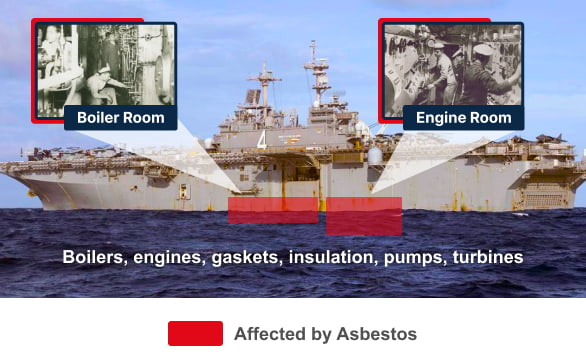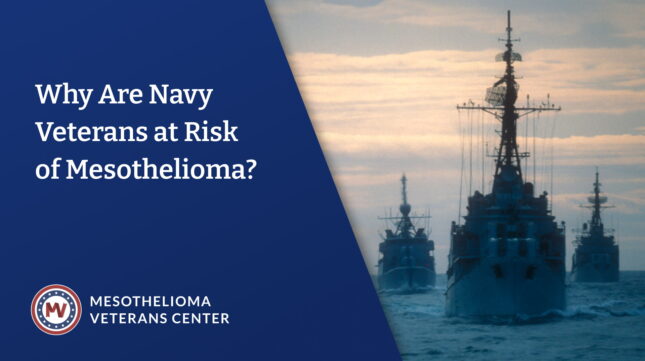Over 570 amphibious warships used by the United States Navy were built using asbestos – a cancer-causing substance. As a result, many Navy and Marine Corps veterans who served on amphibious warships are at risk of a cancer called mesothelioma. We can help veterans harmed by asbestos on amphibious warships get VA benefits, including medical care and monthly compensation.
Did Amphibious Warships Use Asbestos?
Yes, almost all amphibious warships built by the U.S. Navy contained asbestos-based products for more than 50 years.
Between the 1930s and early 1980s, amphibious warships relied on asbestos to resist heat and explosions. Anyone aboard these vessels may have been exposed to asbestos products such as insulation and gaskets, putting them at risk of serious illnesses like mesothelioma, asbestosis, and lung cancer later in life.
Video Summary: U.S. Navy veterans are at a high risk of mesothelioma due to the use of asbestos on Navy ships. The Mesothelioma Veterans Center can help affected veterans and families pursue benefits, medical care, and financial aid if eligible. View Transcript
Military members who served between the 1930s and 1980s were very likely exposed to asbestos, particularly in the Navy, because asbestos was used throughout the ships to insulate pipes and insulate their boiler systems.
And being that you were a sailor on a ship, you would've likely been on ship for months at any given time. And that's why we see the highest rate of mesothelioma cases in Navy veterans.
Veterans diagnosed with asbestos-related diseases are entitled to several different types of benefits from the VA, to include disability benefits, [and] health care benefits. There are even survivor benefits for those with asbestos-related diseases.
If a veteran believes they were exposed to asbestos while serving in the military, we encourage them to call the Mesothelioma Veterans Center so that we can work together to help them file for VA benefits.
That said, U.S. Navy personnel didn’t know asbestos on amphibious warships was dangerous. Private companies that made asbestos materials hid the health risks, making millions of dollars while poisoning brave service members.
U.S. veterans with mesothelioma or other service-related cancers can pursue military benefits from the U.S. Department of Veterans Affairs (VA), compensation to cover health care costs, and justice by working with our team.
Get our Free Veterans Packet to learn how we can help you access VA benefits and other key resources you may be eligible for.
List of Navy Amphibious Warships With Asbestos
More than 570 amphibious warships commissioned by the U.S. Navy were built with asbestos-containing products.
Amphibious warships that used asbestos included:
- USS Accomac
- USS Achernar
- USS Anchorage
- USS Barber
- USS Block Island
- USS Boxer
- USS Chara
- USS Cleveland
- USS Crescent City
- USS Dent
- USS Dorchester
- USS Dutchess
- USS Earhart
- USS El Paso
- USS Estes
- USS Fallon
- USS Fort Snelling
- USS Freestone
- USS Gallatin
- USS Gilliam
- USS Greene
- USS Haines
- USS Herbert
- USS Hubbard
- USS Inchon
- USS Ira Jeffery
- USS Iwo Jima
- USS Jenks
- USS Joseph T. Dickman
- USS Julius A. Raven
- USS Kingsbury
- USS Knox
- USS Knudson
- USS Lacerta
- USS Laurens
- USS Lenawee
- USS Magoffin
- USS McFarland
- USS Mercer
- USS Napa
- USS Navarro
- USS Noble
- USS Okanogan
- USS Overton
- USS Oxford
- USS Panamint
- USS Pocono
- USS Pondera
- USS Queens
- USS Raleigh
- USS Randall
- USS Sandoval
- USS Seminole
- USS Sims
- USS Taconic
- USS Teton
- USS Todd
- USS Union
- USS Upham
- USS Uvalde
- USS Valeria
- USS Vancouver
- USS Virgo
- USS Wantuck
- USS Weiss
- USS Williamson
- USS Wyandot
- USS Xenia
- USS Yancey
- USS Zenobia
Please note that the list above isn’t a complete one. You may have been exposed to asbestos on amphibious warships or other U.S. Navy vessels not listed above. Our team can help you determine if a ship you served on put you at risk.
How Was Asbestos Used on Warships?
Asbestos was used in many different products aboard amphibious vessels and other Navy ships.
Products containing asbestos on amphibious warships included:
- Boilers
- Engines
- Gaskets
- Insulation
- Pipes
- Pumps
- Turbines
As asbestos products wore down or were serviced, fibers could be released into the air. Any Navy or Marine Corps personnel on amphibious ships could breathe in or swallow these asbestos fibers.


It often takes 10 to 50 years before symptoms of asbestos-related diseases appear after exposure. Navy veterans who worked with asbestos-based insulation, gaskets, and other products aboard amphibious warships decades ago may still be at risk today.
Testimonial“I was a boiler tender when I went aboard my first ship and started doing my first job. I asked them what material it was made out of and they told me asbestos. It didn’t kill anybody on the spot, that’s for sure. It took years later. That’s when it starting catching up with us.”
Government mandates required the use of asbestos aboard all U.S. Navy vessels. Service members didn’t know the dangers as manufacturers hid the truth to keep making a profit.
Who Was at Risk of Exposure to Asbestos on Amphibious Warships?


High-risk jobs aboard amphibious warships included:
- Boiler room workers or tenders
- Engine room workers
- Insulators
- Machinists
- Pipefitters
- Plumbers
- Shipyard workers
- Welders
There is no safe level of asbestos exposure, but those exposed on a regular basis have a greater chance of getting sick later on. Navy veterans who served in the jobs listed above routinely worked with asbestos on amphibious warships, increasing their risk.
The Mesothelioma Veterans Center can help you pursue VA benefits, medical care, and compensation if you or a veteran you love one has mesothelioma. Get started now with our Free Veterans Packet.
Compensation for Veterans Harmed By Asbestos on Amphibious Warships
U.S. veterans with asbestos-related illnesses often qualify for financial compensation by filing lawsuits, trust fund claims, and VA benefits claims.
Explore your mesothelioma compensation options below if you’re fighting this cancer after serving on an amphibious warship decades ago.
Mesothelioma Lawsuits
Veterans can work with top asbestos lawyers to file mesothelioma lawsuits and pursue a financial payout. The average mesothelioma lawsuit awards $1 - $1.4 million through out-of-court settlements, allowing veterans to cover expenses without a trial.
We've secured significant payouts worth millions of dollars for other veterans who developed mesothelioma decades after serving on amphibious warships.
Amphibious warship mesothelioma settlements we've secured include:
- $3.84 million to an Illinois Navy machinist mate who developed peritoneal mesothelioma after serving aboard the USS Point Defiance
- $3.78 million to a Navy veteran from Pennsylvania who served as a gunners mate on USS Lloyd S. Carlson and USS David Stone
- $2.98 million to a West Virginia Navy veteran who contracted pleural mesothelioma from serving on the USS Valley Forge
- $2.7 million to a Navy veteran from Arizona who developed mesothelioma after serving as an electrician’s mate on the USS Duluth, USS Hamul, and USS Lea
- $2.69 million for a Marine Corps veteran from Kansas with mesothelioma from the USS Sumter
When veterans work with our partner law firm, mesothelioma lawsuits are not filed against the U.S. military or government. Further, our partners handle all the work involved with a lawsuit, meaning there’s no extra stress for veterans or their families.
Call (877) 450-8973 now to find out if you or a loved one qualifies to file a lawsuit and retrieve compensation after a mesothelioma diagnosis.
Asbestos Trust Funds
Many companies that made or sold asbestos products used on amphibious warships filed for bankruptcy to avoid lawsuits. However, the U.S. court system forced these companies to put money into asbestos trust funds to compensate victims.
There are dozens of active trusts with over $30 billion available in total. With a lawyer’s help, you may be able to get the first payouts from trusts in 90 days or less — without going to court.
VA Benefits
Veterans diagnosed with mesothelioma after exposure to asbestos on amphibious warships may be able to access a wide range of VA benefits.
Notable mesothelioma VA benefits include:
- Disability compensation worth almost $4,000 a month in most cases
- Health care from top VA mesothelioma doctors and hospitals
- Pension plans
- Survivor benefits
Veterans with mesothelioma typically receive a 100% disability rating from the VA, meaning they receive the highest monthly payouts and lowest medical premiums.
Our VA-accredited mesothelioma lawyers can help increase your disability rating if you already have benefits. Further, you can file VA claims, trust fund claims, and lawsuits all at the same time.
Get started by working with our team right now.
Help for Amphibious Warship Veterans With Mesothelioma
Many U.S. Navy veterans defended our country while serving on amphibious warships loaded with asbestos products.
Decades later, many of these veterans are fighting cancers like mesothelioma since manufacturers of asbestos-based products never revealed the dangers of this substance.
If you or a loved one developed mesothelioma after serving on amphibious warships or other Navy vessels, our team stands ready to assist you.
Here are 4 next steps we recommend:
- Call (877) 450-8973 to connect with our patient advocates
- Connect with top doctors and hospitals with help from our nurses
- File for or increase your VA benefits
- Seek compensation often worth $1 million+
Get a Free Veterans Packet to see if you can pursue VA benefits and other top resources with help from our team.
Asbestos on Amphibious Warships FAQs
Is there still asbestos on Navy ships?
Only a few older U.S. Navy ships contain asbestos in the present day.
Once the danger of asbestos became well known, it was no longer used to build new amphibious warships or other Naval vessels. Major renovation projects were also taken to remove asbestos from almost all Navy ships in the 1980s.
Still, there is no way to prevent mesothelioma after exposure, so veterans exposed before the early 1980s could be at risk of this cancer today.
We can help U.S. veterans harmed by asbestos on amphibious warships get VA benefits, compensation, and justice. Call (877) 450-8973 now to get started.
Where is asbestos found on ships?
Asbestos was found throughout amphibious warships, including engine rooms, boiler rooms, and navigation rooms.
Any Navy service members who worked with or around these products could go on to develop mesothelioma 10-50 years later.
How many veterans were exposed to asbestos on amphibious warships?
It’s likely that millions of military veterans were exposed to asbestos on amphibious warships and other vessels. This is because almost every Navy ship was built with asbestos before the dangers were known.
One out of three mesothelioma patients today served in the U.S. Navy or worked in shipbuilding.
Do I qualify for benefits if I was exposed to asbestos on amphibious warships?
Yes, you may qualify for VA benefits if you were exposed to asbestos on amphibious warships and later developed mesothelioma or another asbestos-related disease.
Notable VA benefits include monthly disability compensation worth almost $4,000 a month and free or inexpensive medical treatments.
We can help you file for or increase your VA benefits and other forms of compensation right now.



